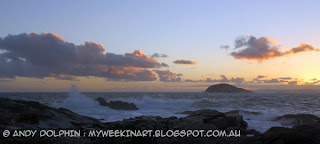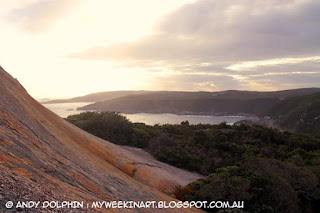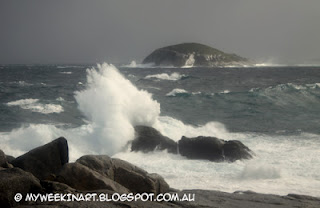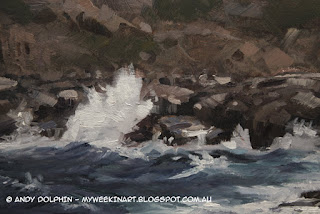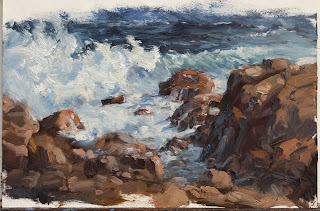View to Green Islands, Albany. Photo by Andy Dolphin.
Weather Forecast: Becoming fine.
I returned to Torndirrup National Park yesterday afternoon in the hope of capturing the sea at its best as we'd had a bit of stormy weather the day before. When I arrived, there was a decent swell combined with a high tide pushing some big waves into shore. A gentle, warm breeze made conditions perfect for painting.
I love the way some waves hit the rocks and explode. There's no other way to describe it. The best of them even send out a solid "boom!" when they hit. You can feel it in your chest.
I set up in a moderately comfy spot well above the wave line and got to work. Using ultramarine, burnt sienna and cad yellow light, I looked straight into the sun and got this...
(Boom! Sketch. 30x25cm oil on board. © Andy Dolphin)
For a plein air piece, I'm pretty happy with it. There's a lot going on when you're there, on site. Every wave is different and they don't all go "boom!" right where you want them to - and a lot of those that do go "boom!" in the right place, do it when you're looking elsewhere. The clouds shift constantly so the sheen on the water comes and goes and the sun sets quickly, dropping more into view and changing the colour of everything. I tried to ignore all that and spent just over an hour on this painting.
This morning, without looking at yesterday's painting, and relying solely on memory, I did a quick digital sketch of the "same" subject. There's about half an hour's work here...
(Boom! Digital sketch. 800x600px. © Andy Dolphin)
The beauty of working from memory like this is that reality doesn't interfere. With the memory of yesterday still vivid, I can design things the way I want them, out of my head. I put rocks where I want them, invent wave directions and use colours that I feel will achieve the desired result.
It can be difficult to make such decisions in the field with a scene that always looks exciting but which won't stay still. For example, I noticed at one point that the splashes of the waves were casting very clear shadows across the foreground water at times, but installing those shadows into a half-finished oil sketch can be problematic because there just isn't time to be fussing with it. But those shadows were still clear in my mind this morning and I made sure to use them in the digital sketch.
The photo at the top of the article shows how the day ended, shortly after I'd packed up. What an awful way to have to spend an afternoon eh?

